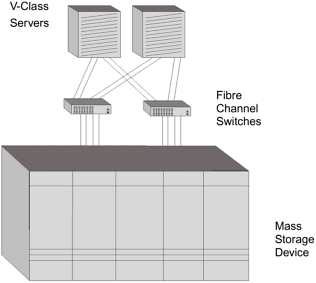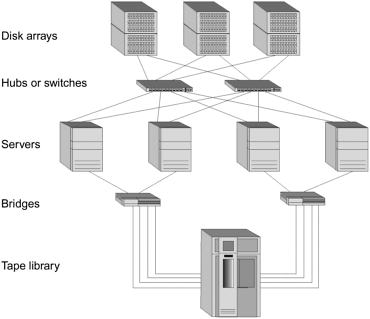7.2 General SAN Implementations
| only for RuBoard - do not distribute or recompile |
7.2 General SAN Implementations
There are certain general types of SAN implementations. You are likely to see them in any large IT operation, regardless of the industry sector. The next few pages will discuss several major ones.
7.2.1 NT Consolidation
Consolidating and centralizing server and storage assets through the creation of clusters can satisfy some of the sharing needs. The clustering concept is a key for users who need high server availability.
Figure 7-1. NT Consolidation

International Data Corporation defines four principal types of clustering:
-
High-availability clustering ” system managed failover to another node within the cluster.
-
Administrative clustering ” management and allocation of resources from across the cluster.
-
Application clustering ” management of a specific application across a cluster through tight integration of its own automated program interface (API).
-
Scalability clustering ” a specific workload spread across multiple nodes with the use of system functions.
7.2.2 Mission Critical Application Server
Mission critical refers to that data or application that is so absolutely necessary to the survivability of the business that if the data is lost or the application goes down, so does the business.
Figure 7-2. Mission Critical Implementation

Therefore, environments supporting mission critical applications need their components and connectivity to be as robust as possible. This implies the implementation of dual pathing (HBAs and cables) and redundancy of infrastructure components (hubs and switches) to ensure the data flow is uninterrupted.
When implementing higher levels of availability to meet business demands, remember that the cost of equipment and associated components increases with the amount of availability needed. However, this may be cost-justified if the downtime costs for your enterprise are high.
7.2.3 High Availability Application Server
High availability implies that your data and devices are available for use at all times. It also means there is no single point of failure, either in the components themselves or in the connectivity of the components.
High availability also refers to the ability to allocate or remove resources to and from the SAN, to recover from breakdowns or expand for growth without impacting performance or the accessibility of data. High availability comes built in to the hardware in the form of multiple components within a device (for example, dual power supplies in a disk array).
Sometimes high availability comes in the form of software; for example, an application that runs between two servers in a cluster. The application knows when one server fails and automatically switches control over to the remaining good server.
Another example would be a software package that automatically creates a mirror image of a valuable database from one disk array to another or to another LUN within the same disk array.
7.2.4 Disaster Recovery/Backup
Disaster recovery and data backup are two of the hottest subjects in the industry today. Figure 7-3 demonstrates a possible solution that SANs provide. Here, there is a simple direct connection of servers to a tape library, capable of simultaneously moving data from more than one disk array to the tape library.
Figure 7-3. Disaster Recovery/Backup

All businesses need to protect their data. It is absolutely critical for data to be backed up in order to be prepared for disaster recovery. Whether the backup is done in the same room, across campus, or at a geographically remote site, it is a necessary evil.
This is a complicated subject, and has been covered in detail in Chapter 6. However, it s illustrated here again, as it is one of the primary driving forces for SANs. Figure 7-3 shows tape library sharing by the servers Fibre Channel connections (useful for distance) and FC/SCSI bridges (useful for compatibility). Native Fibre Channel tape libraries, with a direct connection to the SAN, have been announced and are on the immediate horizon.
Zero downtime and instant recovery are the two most frequent discussion topics of disaster recovery. No one wants his or her system to be down for any amount of time; when the system goes down, data must be instantly accessible by another system.
| only for RuBoard - do not distribute or recompile |
EAN: 2147483647
Pages: 88